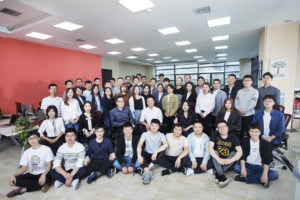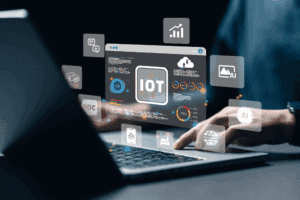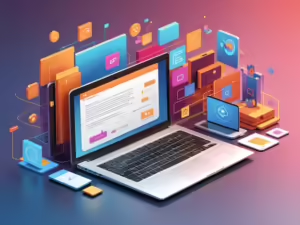IoT development refers to the process of designing, building, and maintaining Internet of Things (IoT) solutions. The development of IoT involves hardware integration, software programming, and cloud connectivity to enable smart devices to collect and exchange data.
The Internet of Things (IoT) development has emerged as a revolutionary force, seamlessly interweaving the physical and virtual worlds. At the heart of this transformative wave lies IoT development—a dynamic and innovative field that holds the key to unlocking unprecedented connectivity and efficiency across industries.
What is IoT Development and How Does It Work?
Before delving into the intricacies of IoT development, let's grasp the essence of the Internet of Things. Simply put, IoT refers to the network of interconnected devices, objects, and systems that communicate and share data with each other over the internet. These devices can range from everyday objects like refrigerators and thermostats to complex machinery in industrial settings.
The Promise of Connectivity
The primary goal of IoT is to enable these devices to collect, exchange, and analyze data in real-time, fostering a level of connectivity that transcends traditional boundaries. Imagine a world where your home adapts to your preferences, your car communicates with traffic signals, and your city optimizes energy consumption based on real-time demand. This interconnectedness forms the foundation of a smarter, more efficient, and responsive world.
Development of IoT : Key Technologies and Processes
Bridging the Physical and Digital Realms
At its core, IoT development is the process of creating and enhancing software and applications that facilitate the seamless integration of devices into the IoT ecosystem. This involves designing and implementing communication protocols, data analytics, and security measures that allow devices to function harmoniously within the IoT network.
Creating Intelligent Ecosystems
IoT development goes beyond mere connectivity. It involves imbuing devices with intelligence, enabling them to make informed decisions based on the data they collect. This intelligence could manifest in predictive maintenance for machinery, personalized recommendations for users, or even real-time adjustments to environmental conditions.
The Building Blocks of IoT Development
- Sensors and Actuators: These are the eyes and hands of IoT devices, collecting data from the physical world and translating digital commands into actions.
- Connectivity Protocols: IoT devices rely on various communication protocols such as MQTT, CoAP, or HTTP to exchange data efficiently and securely.
- Cloud Computing: The cloud serves as the backbone of IoT development, providing the storage and processing power necessary to handle the vast amounts of data generated by interconnected devices.
- Security Measures: Given the sensitive nature of the data involved, robust security measures, including encryption and authentication, are paramount in IoT development.
The Impact of IoT Development: Why IoT Development is Important for Businesses
Industry Transformation
IoT development is reshaping industries across the board. In healthcare, it facilitates remote patient monitoring; in agriculture, it optimizes resource usage; and in manufacturing, it streamlines production processes. The possibilities are virtually limitless.
Enhanced User Experience
On a personal level, IoT development enhances the user experience by creating smart homes, wearable devices, and personalized services that adapt to individual preferences. This not only adds convenience but also elevates the quality of life.
Sustainability and Efficiency
Through real-time monitoring and data-driven decision-making, IoT development plays a pivotal role in promoting sustainability and efficiency. From smart energy grids to waste management systems, IoT is at the forefront of creating a more sustainable and interconnected world.
What is IoT Developer
An IoT Developer is a professional who designs, builds, and maintains Internet of Things (IoT) solutions by integrating hardware, software, and cloud technologies. IoT developers work on creating smart devices, ensuring seamless connectivity, and developing applications that process and analyze data from IoT sensors.
What is an IoT Developer Responsible for
- Embedded Systems Development: Writing firmware and software for microcontrollers and IoT hardware.
- IoT Communication Protocols: Implementing communication standards such as MQTT, CoAP, Bluetooth, and LoRaWAN.
- Cloud Integration: Connecting IoT devices to cloud platforms like AWS IoT, Azure IoT Hub, or Google Cloud IoT.
- Data Security: Ensuring secure data transmission and device authentication using encryption methods.
- AI & Edge Computing: Implementing AI algorithms on IoT edge devices for real-time data processing.
Skills Required for IoT Development
An IoT Developer typically needs expertise in:
- Programming Languages: C, C++, Python, Java, or JavaScript.
- Embedded Systems: Knowledge of ARM, Raspberry Pi, ESP32, or other microcontrollers.
- Networking & Protocols: Understanding of TCP/IP, HTTP, and wireless communication.
- Cloud & Data Analytics: Working with IoT cloud platforms and big data analytics tools.
Why IoT Developers are in High Demand?
With the rapid growth of smart homes, industrial automation, and AI-powered IoT devices, the demand for skilled IoT developers is rising. Businesses require experts who can design scalable, secure, and efficient IoT ecosystems to stay competitive in the market.
Challenges and Future Thoughts
While the potential of IoT development is immense, it comes with its set of challenges, including security concerns, interoperability issues, and the need for standardized protocols. However, as technology continues to advance, these challenges are being met with innovative solutions, propelling IoT development into a future where the possibilities are limited only by our imagination.
In conclusion, IoT development is not merely a technological trend; it is a paradigm shift that is redefining the way we interact with the world around us. As we stand on the cusp of a new era, the realm of IoT development beckons, inviting developers and innovators to shape a future where connectivity knows no bounds, and intelligence resides in every device we touch.
FAQ
What services are included in IoT development?
IoT development typically includes IoT consulting, IoT platform development, embedded hardware design, cloud integration, mobile app development, and data analytics services.
What does an IoT developer do?
An IoT developer designs and builds connected solutions that span both hardware and software layers, often incorporating edge computing, mobile applications, and cloud integration.
Can I hire remote IoT developers for my project?
Yes. We offer dedicated IoT developers who can work remotely to deliver custom end-to-end solutions across industries.
Transform Your Business with Our AI + IoT Expertise
With 10 years of experience, ZedIoT leads the way in AI and IoT development. We offer tailored solutions that integrate AI with IoT, driving innovation and efficiency across industries. Partner with us to leverage our expertise and achieve your business goals. Contact us today to explore our comprehensive services.
???? Explore our IoT development services →
???? Hire Dedicated Remote Developers for IoT and AI Projects →



